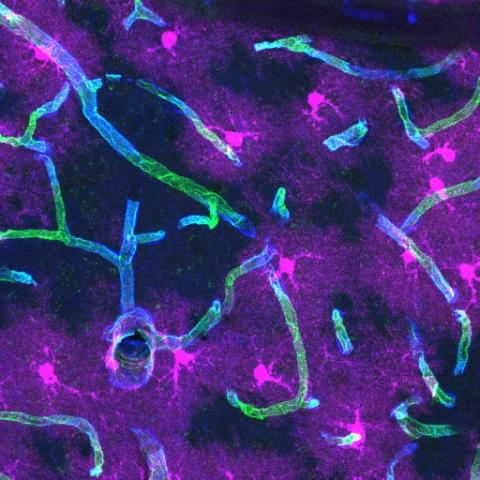A new study led by Dr Blanca Díaz Castro (UK DRI at Edinburgh) uncovers how specialised cells in the blood-brain barrier communicate in health and disease. The research, published in Nature Communications, could lead to new therapeutic targets for neurodegenerative conditions.
What was the challenge?
Blood vessels serve to maintain an ideal environment in the brain, by tightly regulating the exchange of substances between the blood and the brain via the blood-brain barrier – a protective layer of cells that separates the blood from the brain. Here, blood vessel cells in the brain (called endothelial cells) sit next to astrocytes, a type of supporting brain cell.
Research has shown that blood-brain barrier functions are altered with age, and in many neurodegenerative conditions. Despite the essential role of these specialist cells in the blood-brain barrier, scientists’ knowledge of how these cells communicate to maintain the brain’s health in coordination with the body is remarkably limited.
What did the team do and what did they find?
In this study, researchers developed a new way to identify all the proteins found in the parts of astrocytes that come into contact with endothelial cells in mice, known as the astrocyte ‘endfoot’. By combining the mouse astrocyte endfoot data with genetic data from the endothelial cells, they discovered specific signalling pairs – molecules that let the two cell types “talk” to each other.
When the mice were exposed to inflammation in the body, the researchers found that the communication signals changed. The team also found that over 80% of these same cell-to-cell signals exist in the human brain, and some of them are altered in people with multiple sclerosis or Alzheimer’s, compared to healthy people.
Our findings show that communication between astrocytes and endothelial cells is dynamic, changing during inflammation and disease. Understanding these signals could open up new ways to protect the brain in conditions like Alzheimer’s and multiple sclerosis.
Group Leader
What is the impact?
This study reveals new understanding of how brain blood vessels and astrocytes communicate, how this changes during inflammation and disease, and provides valuable tools to study this in both mouse and humans.
Reference: Hill, S.A., Bravo-Ferrer, I., Čiulkinytė, A. et al. Molecular profiling of brain endothelial cell to astrocyte endfoot communication in mouse and human. Nat Commun 16, 9750 (2025). https://doi.org/10.1038/s41467-025-65487-4

